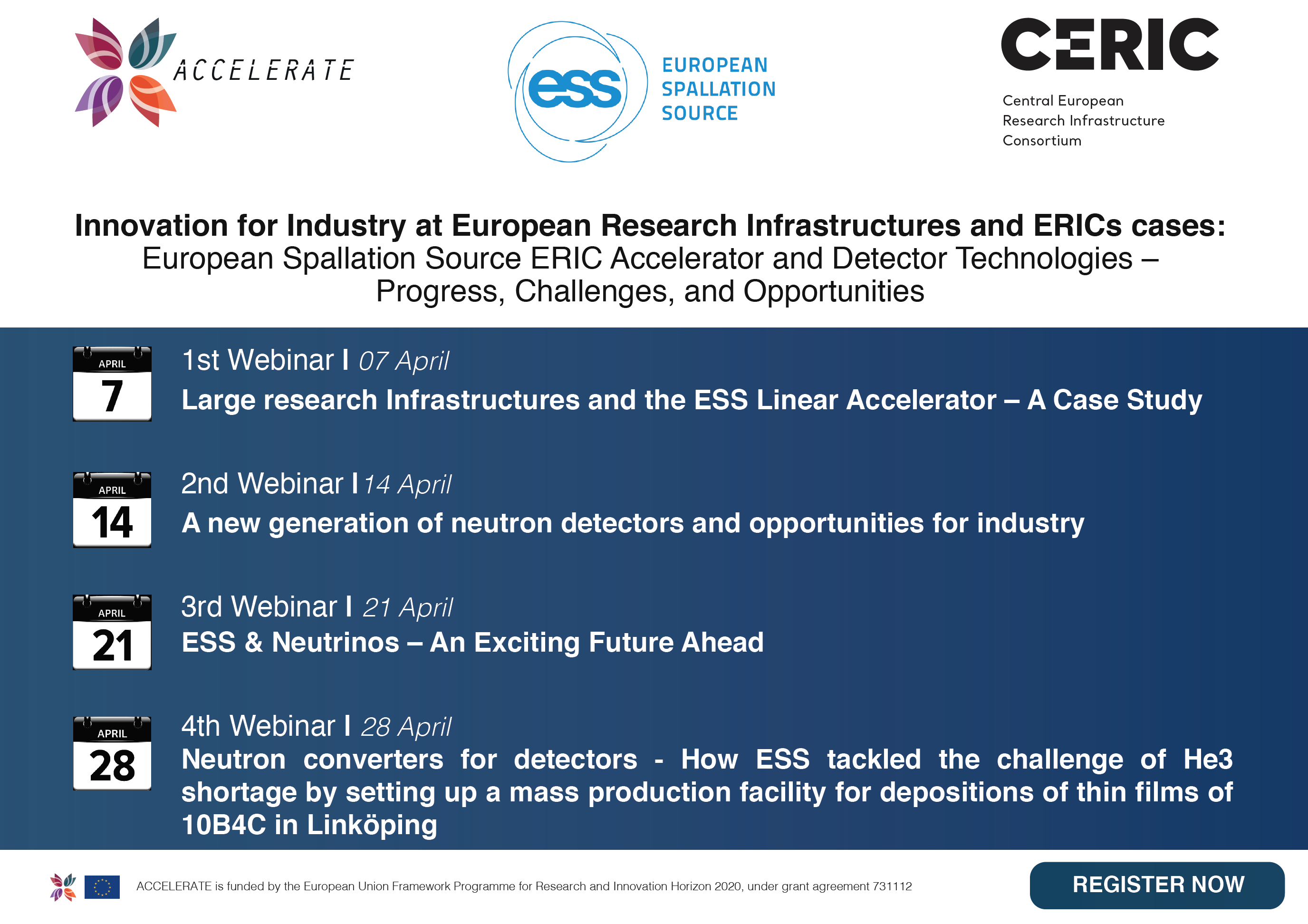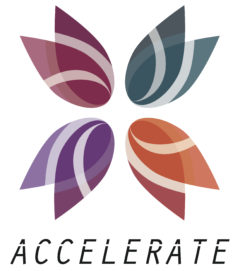
In the frame of the H2020 project ACCELERATE, a series of webinars highlighting examples and cases of innovation for industry at European Research infrastructures in general, and ERICs in particular will be held in April 2021. Each talk will be facilitated by an expert in the field from the European Spallation Source.

-
Overview
Access to large scale Research infrastructures: CERIC –ERIC and Accelerate Project
CERIC- Central European Research Infrastructure Consortium´s CERIC’s main aim is to contribute to the creation of excellent science, both as in-house activity and as a service to international users. This is achieved mainly by providing access to its research facilities, addressing researchers requiring the use of one or more complementary techniques for structural investigation, analysis, synthesis and imaging of materials and biomaterials down to the nano-scale. The ACCELERATE project brought together CERIC´s research infrastructure and other large research facility with the aim of supporting the long-term sustainability of large scale research infrastructures (RIs).
The ESS Linear Accelerator – A Case Study
The proton linear accelerator of the European Spallation Source will be the world’s most powerful in term of MW of beam power on the target. This is achieved with a high-intensity normal-conducting low-energy part, followed by more than 300 m of state-of-the-art superconducting accelerating structure of three different kinds. Additional large systems generate the electromagnetic fields that accelerate the protons, provide helium at 2 K to cool the superconducting structures, etc.
The accelerator project is a collaboration between more than 20 universities and laboratories in most of the 13 ESS member states. More than half of the approximately 500 M€ budget for the accelerator is contributed from these partners, and industry in the member states is heavily involved.
This presentation will give an overview of the accelerator and its most important sub-systems, and it will describe some of the associated technical challenges. The construction is well under way, and many components have been delivered from our partners. Installation, testing and commissioning is in progress, and impressions from these activities will be given.
The speaker of the 1st webinar is Dr. Håkan Danared, Deputy head of Accelerator Division at the European Spallation Source. Read here the speaker’s biography.
Register to the 1st webinar here.
-
Overview
CERIC large research infrastructure solutions. Neutrons applied to industry
CERIC, Central European Research Infrastructure Consortium offers tailored services to boost industrial research and development activities related to the characterization and modification of materials in the fields of energy, health, food, cultural heritage and more. With excellent facilities in 9 countries in Central and Eastern Europe (Austria, Croatia, Czech Republic, Hungary, Italy, Poland, Romania, andSlovenia), CERIC supports proprietary research through a problem-solving approach, using some of the best scientific facilities and expertise in Central and Eastern Europe. Confidentiality is ensured through specific agreements guaranteeing the customer ownership of results. Highlights on neutron applications for industry will be showed
A new generation of neutron detectors and opportunities for industry-ESS
A decade ago, the collapse in the available supply of Helium-3 gas combined with a similar surge in demand for this valuable gas led to the “Helium-3 crisis”. As more than 80% of neutron detectors worldwide were based around this gas, it was a challenge to be able to build neutron detectors for future neutron scattering instruments.
ESS has undertaken a decade long R&D programme, which has reached fruition, and the new generation of neutron detectors are being built for ESS instruments. The need for Helium-3 at has thus been reduced by over 90% as a result of this programme; in addition, these new detectors are higher performant more matching the needs of a new facility.
An overview of how the research and development process was carried out is presented, in particular to give insight in the interactions between a research institute developing a niche and highly specialised product and industry. Along the way the various forms and examples of engagement with industry are noted. Synergies and interactions during this process are outlined.
This webinar is particular timely with the construction of the detectors for ESS just starting leading to potential opportunities in the coming year.
The speaker of this 2nd edition is Dr. Richard Hall-Wilton, Group Leader Detector Technologies at the European Spallation Source. Read here the speaker’s biography.
Register to the 2nd webinar here.
-
Overview
Introduction of the ACCELERATE project.
ACCELERATE project, supports the long-term sustainability of large scale research infrastructures (RIs) through the development of policies and legal and administrative tools and frameworks to improve the offer of tailored services to private and public entities, ensuring outreach to new scientific and industrial communities worldwide and defining common protocols for monitoring and assessing RIs’ socio-economic impact.
ESS and Neutrons
The European Spallation Source (ESS), currently under construction in Lund, Sweden, is the world’s most powerful neutron spallation source, with an average power of 5 MW at 2.0 GeV. The linac accelerates a proton beam of 62.5 mA peak current at 4 % duty cycle (2.86 ms at 14 Hz). The high beam power at ESS will give excellent possibilities for measurements of possible CP violation in the leptonic sector. In the ESS neutrino Super Beam Project (ESSnuSB) it is proposed to utilize this powerful accelerator as a proton driver for a neutrino beam that will be sent to a large underground Cherenkov detector in Garpenberg, mid-Sweden. Current pion focusing schemes at the neutrino target require the pulses to be of the order of microseconds. These short pulses can be achieved by injecting the H⁻ beam into an accumulator ring by charge exchange injection before they are sent to the neutrino target. By adding a second H⁻ beam, interleaved with the proton beam, the duty cycle will be increased to 8 % and the average power to 10 MW. In this talk we discuss the required modifications of the ESS linac to reach an additional 5 MW beam power for neutrino production in parallel to the spallation neutron production.
The speaker of this 3rd edition is Dr. Mohammad Eshraqi, Accelerator Physicist at the European Spallation Source. Read here the speaker’s biography.
Register to the 3rd webinar here.
-
Overview
Introduction of the ACCELERATE project.
ACCELERATE project, supports the long-term sustainability of large scale research infrastructures (RIs) through the development of policies and legal and administrative tools and frameworks to improve the offer of tailored services to private and public entities, ensuring outreach to new scientific and industrial communities worldwide and defining common protocols for monitoring and assessing RIs’ socio-economic impact.
Neutron converters for detectors
Boron carbide (B4C) has been seen as one of practical substitution for helium as the neutron conversion material in neutron detectors, but applying a material in solid state, instead of gas form, also means new challenges for the production. ESS Linköping Detector Coatings Workshop has been working on the process development for reliable productions of B4C thin films in different types of neutron detectors. The thin films deposited are also examined with different analytical tools to check up the qualities, which are crucial for the iteration of further process tuning.
Here, a brief summary is given on why a new neutron converter technique was needed and how we upscaled from first proof of concept to demos and to first sharp coatings. We will also present the project works done to assure the quality of the depositions, to procure highly specialized materials, and to stay in close contact with industry. An overview of how opportunities arise for industries during this development and production process is noted.
In addition to the project operation, we will show examples of the deposition processes that has been developed in the workshop, and the resulting products of B4C films from the processes. Apart from B4C, we will report the capability of depositing other materials that can also be interesting for the design of detectors, for example, metal contact layers.
The speakers of this 4th edition are Dr. Linda Robinson, Section Leader Neutronic Detectors Coating and Dr. Lai Chung-Chuan, Coatings Scientist. Read here the speakers biographies.
Register to the 4th webinar here.



